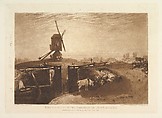Windmill and Lock, part VI, plate 27 from "Liber Studiorum"
Designed and etched by Joseph Mallord William Turner British
Engraver William Say British
Publisher Joseph Mallord William Turner British
Not on view
Turner distilled his ideas about landscape In "Liber Studiorum" (Latin for Book of Studies), a series of seventy prints plus a frontispiece published between 1807 and 1819. In this case he probably etched the image directly onto the copper plate without a preliminary drawing, deriving it from his 1810 oil "Grand Junction Canal at Southall Mill." The conception echoes a famous painting then attributed to Rembrandt ("The Mill", now at the National Gallery, Washington), but mostly celebrates the progress of British commerce. Directed by Turner, the professional engraver Say added mezzotint to detail the windmill, shown at sunset above men who work the gates of a lock near a white horse. The letter "P" above the image indicates Turner's category of Pastoral landscape.
Due to rights restrictions, this image cannot be enlarged, viewed at full screen, or downloaded.


